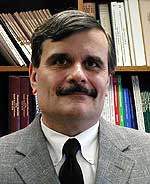By Cara Hetland
Minnesota Public Radio
September 24, 2002
Political scientists in South Dakota say this year's election is the most important they've seen in more than 20 years. The balance of power in Congress is at stake, as well as some long-term political appointments. It's an important year to see what voters are thinking. But there are fewer people agreeing to take polls, and those who do may not be honest about their opinions.
| |
|
|
|
||
They're phrases we hear every election season. Sample rate. Margin of error. All signs of a heated political season. And there's a new phrase in South Dakota - "polling fatigue."
Pollster Jim Meader says South Dakota residents are being bombarded by polls. Special interest groups, candidates and even national party leaders want to know what voters think. He says the problem is South Dakota has a small population.
"We're not New York, we're not California. And they're still going to want generally the same sample size," Meader says. "So if you want a sample size of, let's say 600 people, over time those people are going to be hit quite a few times."
Meader says about half the people called by pollsters refuse to answer questions. He says that high a refusal rate hurts the validity of the numbers.
Bill Richardson, who chairs the University of South Dakota political science department, says part of the reason there's polling fatigue is the personalized approach pollsters take.
|
"There are ways - in terms of polling - just a couple of changes in wording can alter the results. So you have to be very careful ... to make sure you're measuring what's really on people's minds, and not creating opinion that really may not be out there."
- Jim Meader, pollster and political scientist |
"'Hello, Sue Smith, we're calling to conduct a poll,' that is when the recipients of the call instantly know they're no longer anonymous," Richardson says. "You're getting some people who are saying they're undecided when they're probably not. Or people who are reluctant to state their full and complete position on a candidate or candidate's policies. So we can't fully trust the polling."
Richardson studies polls. He calls people after pollsters do, to see what they thought. He says most people know they can manipulate the polls.
Pollster Jim Meader, who's also a political scientist at Augstana College, says people tell the truth. He says there are different kinds of polls, and most people can't tell the difference between them. He says the objective, independent polls are conducted to assure accurate results.
Meader says the wording is key, since there are many ways to ask a question. For instance, "Do you support President Bush's war against terrorism?" Another way to say that is, "Do you support the war on terrorism?" Meader says people tend to support the president when his name is mentioned.
"There are ways - in terms of polling - just a couple of changes in wording can alter the results," Meader says. "So you have to be very careful, in terms of trying to make sure you're measuring what's really on people's minds and not creating opinion that really may not be out there."
The media also plays a role in how polls are portrayed.
Journalists say poll results are interesting and informative. In South Dakota there's only one statewide, independent poll, which is paid for and produced by KELO television. KELO's general manager, Mark Antonitis, says people want to know who's leading in any given race.
"I think it motivates interest," Antonitis says. "I think it motivates voting, too. I think part of our responsibility is ... to inform, enlighten, and get people interested in the election process."
Antonitis admits polling is about ratings, since it can bring in viewers. But he says polls also educate voters.
Each poll costs about $10,000. They offer a snapshot in time of voter opinion - even if voters who participate in the poll aren't completely honest.
More from MPR
